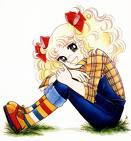
Really, when I m Elementary School, my parents bought me a set of new comic model, different as usually i read. At this age I have favourite comics consists of Smurf, Tin Tin, Lucky Luck or Asterix. But this comics really really different. Then I knew it called manga.
My first impression about Candy-Candy, with sarcastic tone of myself... omg....this kind of comics! roll of my eyes.
Describing of this kind of manga:
The mysterious boy, the romantic boy, the fashionable boy, plus the geeky one, and the much despised spoiled-rich brat; all in one story. But the one I heart the most is the rebel one with a darker image. This is the colorful world of Candy, a cheerful orphaned girl. This is “Candy Candy”.
What are you talking about?
“Candy Candy” is written by Kyoko Mizuki (her real name is Keiko Nagita) and was first published as a novel in 1975 before it was published as a manga illustrated by Yumiko Igarashi. The manga ran for almost four years (1975-1979) in a monthly magazine Nakayoshi (from Japanese publisher Kodansha) and resulted in a total of nine volumes of manga originally. There was also a 115-episode of anime based on the same manga aired initially in 1976.
Are you talking about some three-decade old manga? Gosh, I’m not interested.
And that’s exactly what I had thought before. I read it during middle school, and by then, “Candy Candy” was already almost twenty years since its first publication. I was truly reluctant at first considering I hated the cheesy, wishy-washy love story (you know, shoujo manga, they are for girls). Come on, I’d rather have read Tin Tin or more interest comics series than manga (“Manga is for kids, I’m NOT a kid anymore 'cos i m almost teen you knew!”).
But , I was so wrong as usual. During a stay in my place and nothing to do , my blank holiday with my parents busied with their bussines, and you know you wouldn’t want to go to bed even if you’re told to (particularly WHEN you were told to), I gave “Candy Candy” a try. After all, reading reduces the noise after everyone else falls asleep so the chances of getting discovered that you are not sleeping is also reduced. I was never sleeping all of 'blank holidays' night finishing all nine volumes of the (should I say it again) shoujo manga.
Wow, all the red-eye reading session …
Exactly! And literally my eyes were read when I finished the story since I was crying so much.
Ah, the wishy-washy …
Yes it was, but for a good reason. When you think about most love stories, boy meets girl and they fall in love with each other, and like a fairy tale, they live happily ever after, right?
“Candy Candy” is not so much a love story by that definition. I would consider it as a LIFE story of this orphaned girl called Candy. I don’t want to spoil the story (and rob that first time reading experience from you), but I will say this: true love means wishing the happiness of each other even if it means you have to sacrifice the relationship itself; and happiness does not mean you have to stay together with your true love; and friends and family are the precious gems of life. I guess I spoiled it anyway.
Huh!? So, no happy-ending?
I will say that there is no conclusive ending, but a happy one otherwise. I think what makes it different from most of the shoujo manga out there is that Candy’ love life evolved with her as she grew up just like our own love life (you know how many crushes you have and how many times you change love interests).
And thus, it was easy to be emotionally attached to Candy. I felt her joy and her pain at the same time. She grew up in front of my eyes and I fell in love with the people around her. Somehow, during reading her story, I was pulled into her world with my own world dissolved away. I was living her life then.
Phew, what a nostalgic moment, recalling the time I read “Candy Candy” for the first time. The sweet old days.
Labels: candy-candy, manga, shoujo
0 comments:
Post a Comment